Different Types of Employment Contracts and Their Advantages and Disadvantages
VerifiedAdded on 2023/01/06
|11
|3799
|44
AI Summary
This report discusses the various types of employment contracts, including permanent full-time, part-time, zero-hour casual, and fixed-term temporary contracts. It analyzes the advantages and disadvantages of each contract for both employers and employees. The report also explores how companies like Tesco and ASDA use different contractual methods with examples.
Contribute Materials
Your contribution can guide someone’s learning journey. Share your
documents today.
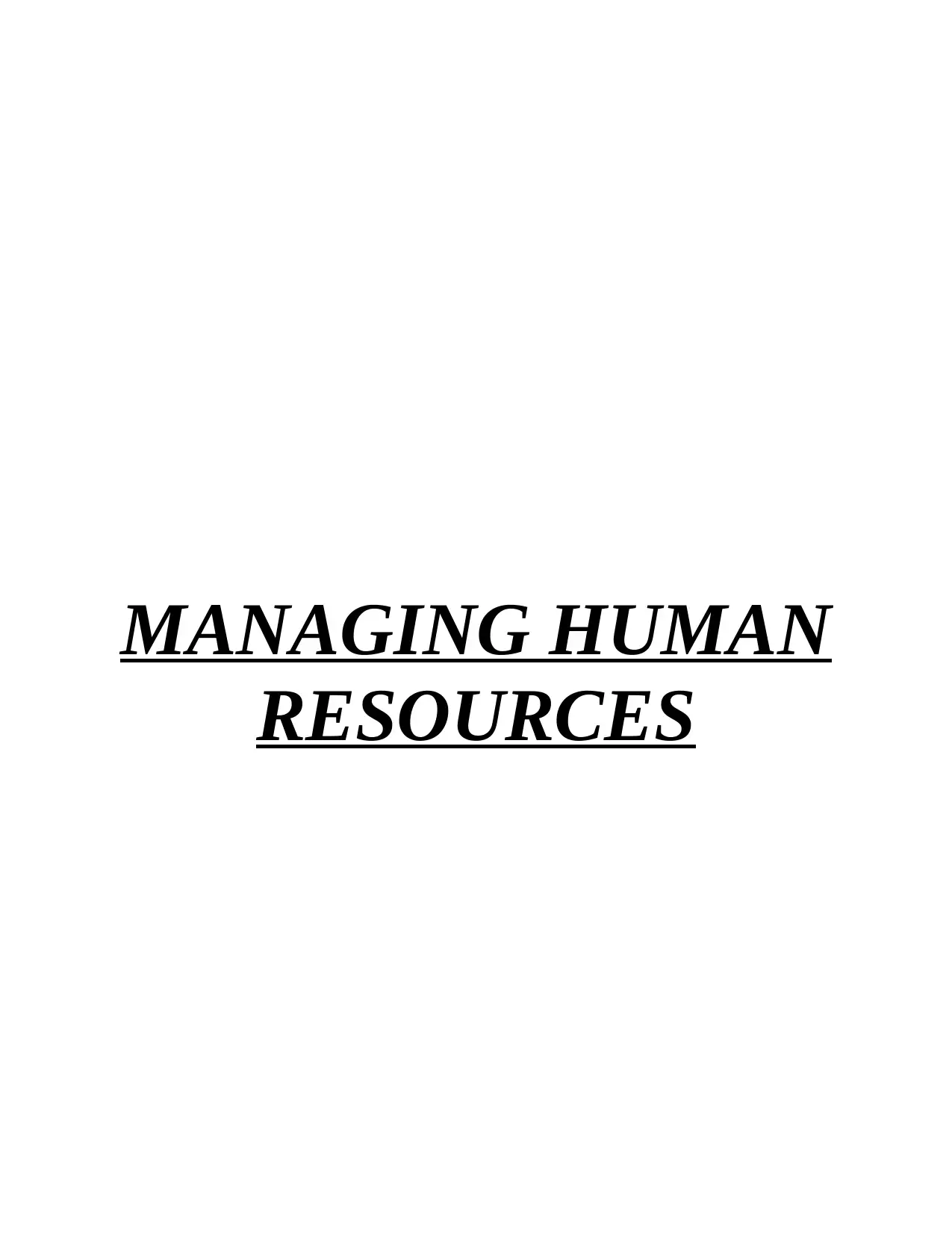
MANAGING HUMAN
RESOURCES
RESOURCES
Secure Best Marks with AI Grader
Need help grading? Try our AI Grader for instant feedback on your assignments.
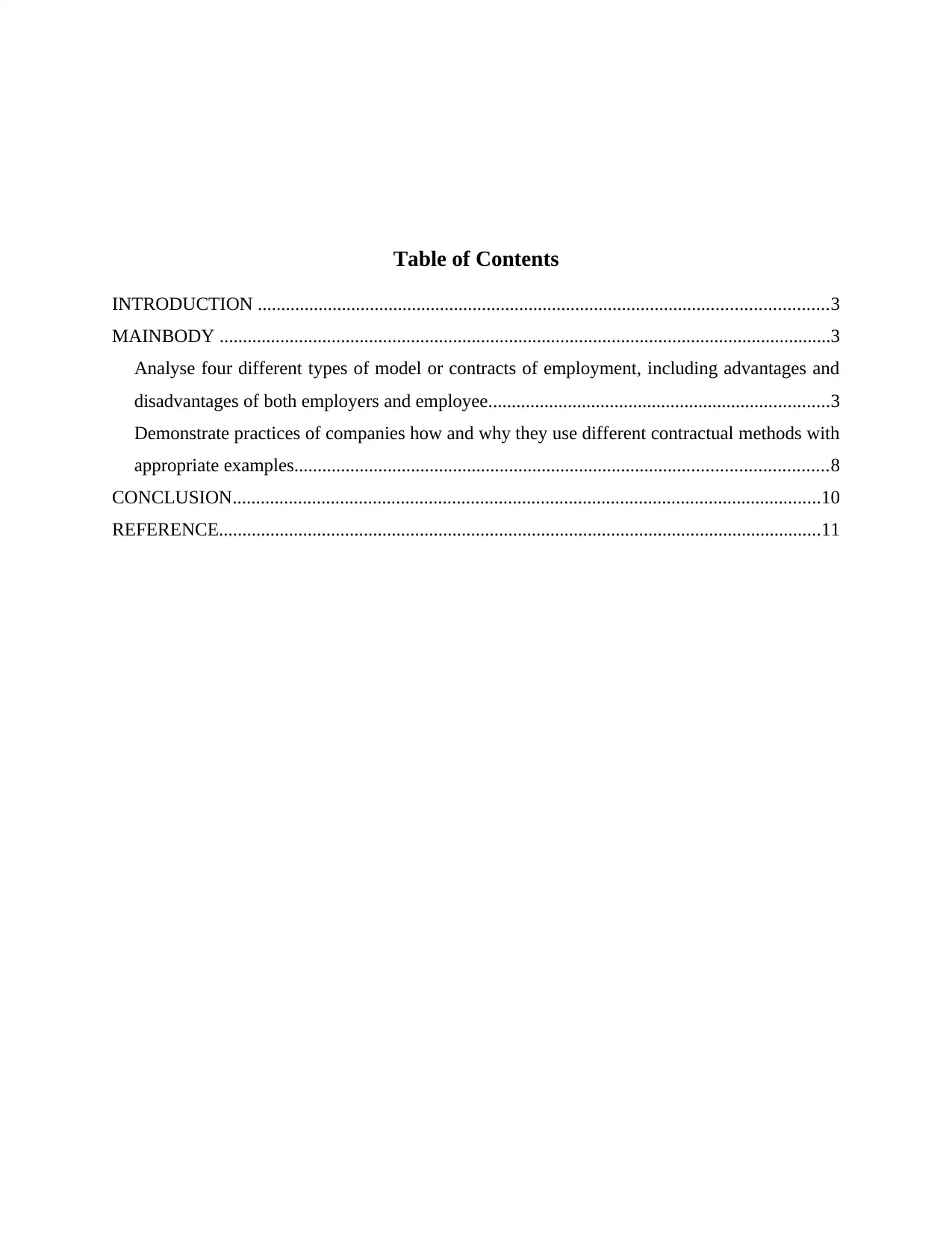
Table of Contents
INTRODUCTION ..........................................................................................................................3
MAINBODY ...................................................................................................................................3
Analyse four different types of model or contracts of employment, including advantages and
disadvantages of both employers and employee.........................................................................3
Demonstrate practices of companies how and why they use different contractual methods with
appropriate examples..................................................................................................................8
CONCLUSION..............................................................................................................................10
REFERENCE.................................................................................................................................11
INTRODUCTION ..........................................................................................................................3
MAINBODY ...................................................................................................................................3
Analyse four different types of model or contracts of employment, including advantages and
disadvantages of both employers and employee.........................................................................3
Demonstrate practices of companies how and why they use different contractual methods with
appropriate examples..................................................................................................................8
CONCLUSION..............................................................................................................................10
REFERENCE.................................................................................................................................11
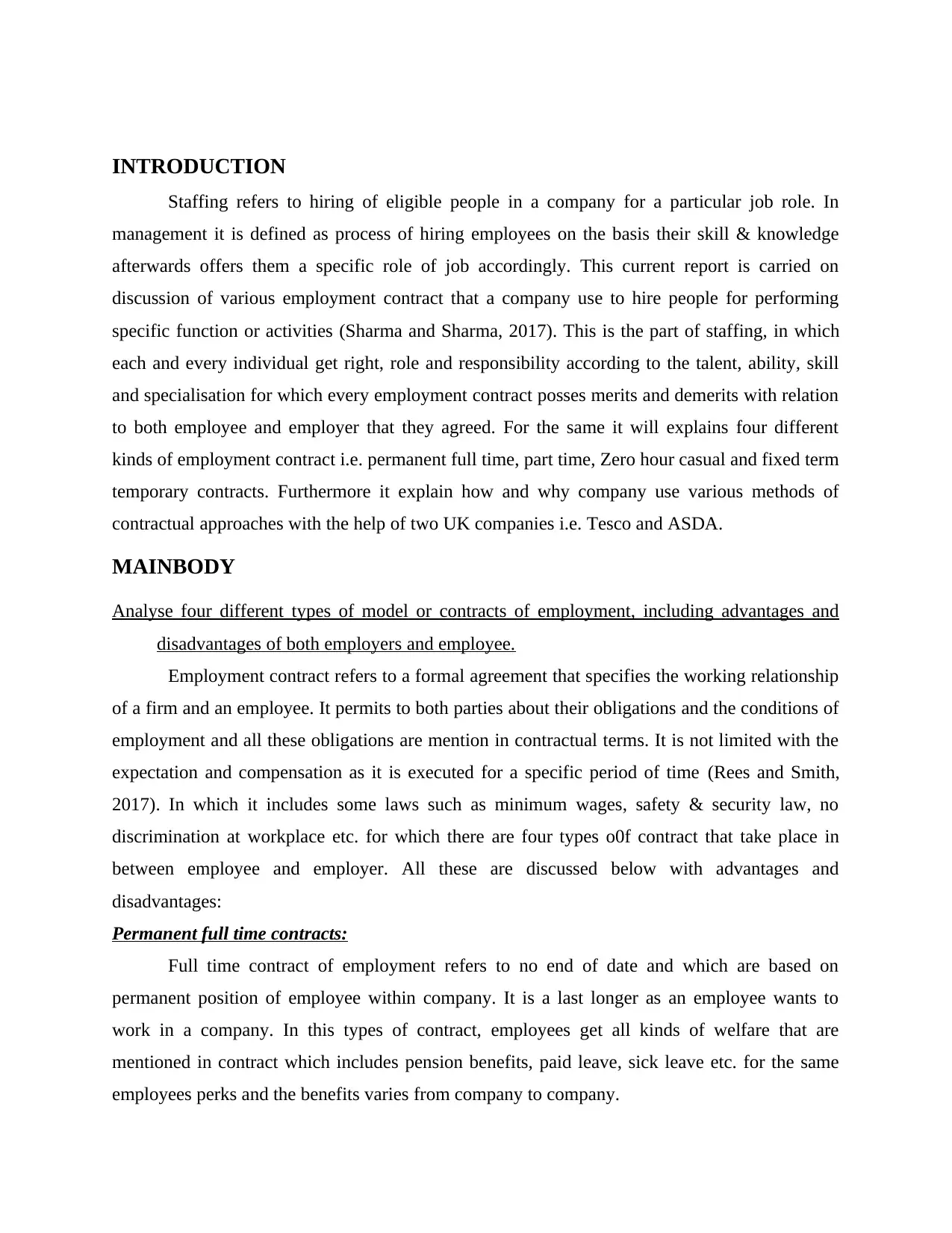
INTRODUCTION
Staffing refers to hiring of eligible people in a company for a particular job role. In
management it is defined as process of hiring employees on the basis their skill & knowledge
afterwards offers them a specific role of job accordingly. This current report is carried on
discussion of various employment contract that a company use to hire people for performing
specific function or activities (Sharma and Sharma, 2017). This is the part of staffing, in which
each and every individual get right, role and responsibility according to the talent, ability, skill
and specialisation for which every employment contract posses merits and demerits with relation
to both employee and employer that they agreed. For the same it will explains four different
kinds of employment contract i.e. permanent full time, part time, Zero hour casual and fixed term
temporary contracts. Furthermore it explain how and why company use various methods of
contractual approaches with the help of two UK companies i.e. Tesco and ASDA.
MAINBODY
Analyse four different types of model or contracts of employment, including advantages and
disadvantages of both employers and employee.
Employment contract refers to a formal agreement that specifies the working relationship
of a firm and an employee. It permits to both parties about their obligations and the conditions of
employment and all these obligations are mention in contractual terms. It is not limited with the
expectation and compensation as it is executed for a specific period of time (Rees and Smith,
2017). In which it includes some laws such as minimum wages, safety & security law, no
discrimination at workplace etc. for which there are four types o0f contract that take place in
between employee and employer. All these are discussed below with advantages and
disadvantages:
Permanent full time contracts:
Full time contract of employment refers to no end of date and which are based on
permanent position of employee within company. It is a last longer as an employee wants to
work in a company. In this types of contract, employees get all kinds of welfare that are
mentioned in contract which includes pension benefits, paid leave, sick leave etc. for the same
employees perks and the benefits varies from company to company.
Staffing refers to hiring of eligible people in a company for a particular job role. In
management it is defined as process of hiring employees on the basis their skill & knowledge
afterwards offers them a specific role of job accordingly. This current report is carried on
discussion of various employment contract that a company use to hire people for performing
specific function or activities (Sharma and Sharma, 2017). This is the part of staffing, in which
each and every individual get right, role and responsibility according to the talent, ability, skill
and specialisation for which every employment contract posses merits and demerits with relation
to both employee and employer that they agreed. For the same it will explains four different
kinds of employment contract i.e. permanent full time, part time, Zero hour casual and fixed term
temporary contracts. Furthermore it explain how and why company use various methods of
contractual approaches with the help of two UK companies i.e. Tesco and ASDA.
MAINBODY
Analyse four different types of model or contracts of employment, including advantages and
disadvantages of both employers and employee.
Employment contract refers to a formal agreement that specifies the working relationship
of a firm and an employee. It permits to both parties about their obligations and the conditions of
employment and all these obligations are mention in contractual terms. It is not limited with the
expectation and compensation as it is executed for a specific period of time (Rees and Smith,
2017). In which it includes some laws such as minimum wages, safety & security law, no
discrimination at workplace etc. for which there are four types o0f contract that take place in
between employee and employer. All these are discussed below with advantages and
disadvantages:
Permanent full time contracts:
Full time contract of employment refers to no end of date and which are based on
permanent position of employee within company. It is a last longer as an employee wants to
work in a company. In this types of contract, employees get all kinds of welfare that are
mentioned in contract which includes pension benefits, paid leave, sick leave etc. for the same
employees perks and the benefits varies from company to company.
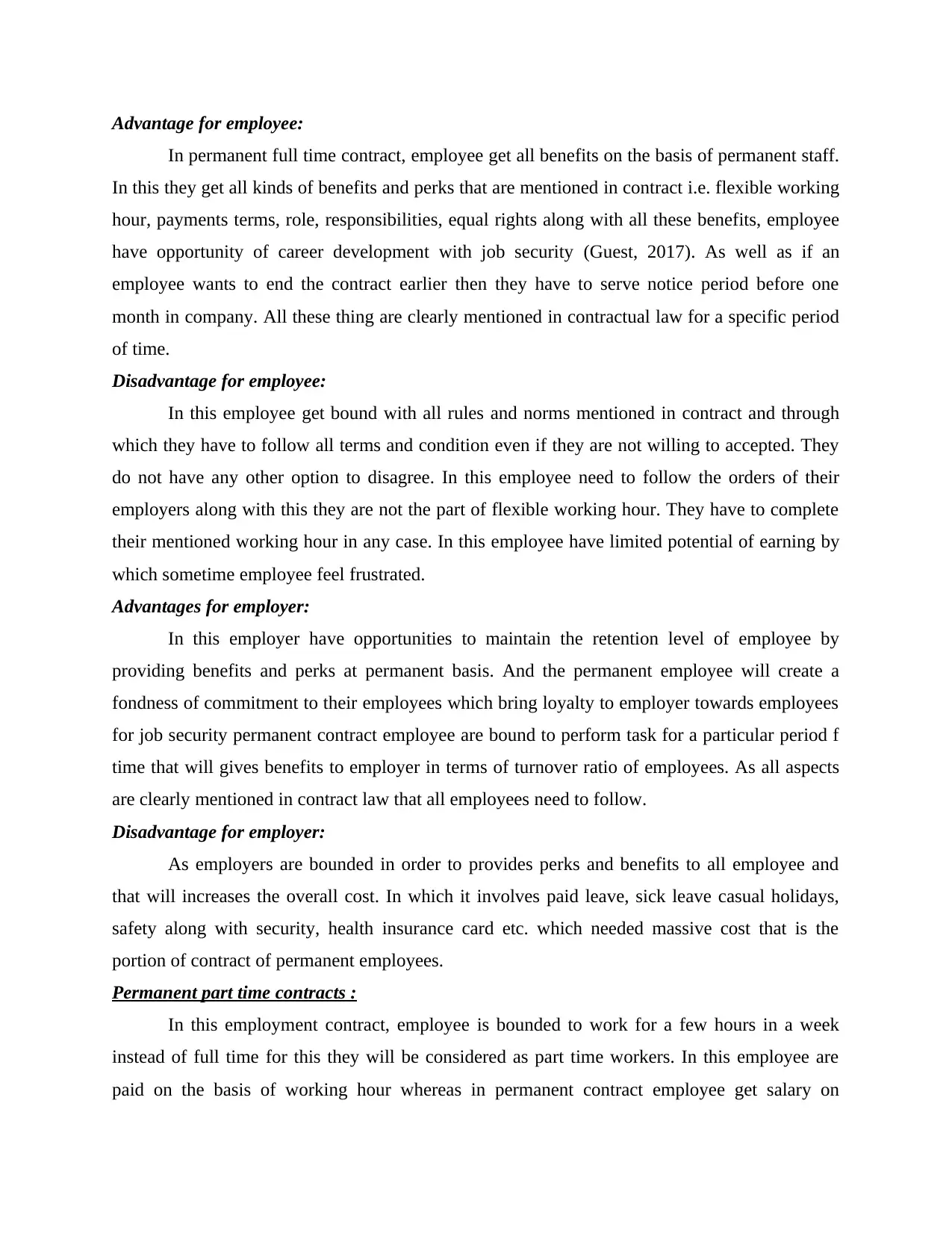
Advantage for employee:
In permanent full time contract, employee get all benefits on the basis of permanent staff.
In this they get all kinds of benefits and perks that are mentioned in contract i.e. flexible working
hour, payments terms, role, responsibilities, equal rights along with all these benefits, employee
have opportunity of career development with job security (Guest, 2017). As well as if an
employee wants to end the contract earlier then they have to serve notice period before one
month in company. All these thing are clearly mentioned in contractual law for a specific period
of time.
Disadvantage for employee:
In this employee get bound with all rules and norms mentioned in contract and through
which they have to follow all terms and condition even if they are not willing to accepted. They
do not have any other option to disagree. In this employee need to follow the orders of their
employers along with this they are not the part of flexible working hour. They have to complete
their mentioned working hour in any case. In this employee have limited potential of earning by
which sometime employee feel frustrated.
Advantages for employer:
In this employer have opportunities to maintain the retention level of employee by
providing benefits and perks at permanent basis. And the permanent employee will create a
fondness of commitment to their employees which bring loyalty to employer towards employees
for job security permanent contract employee are bound to perform task for a particular period f
time that will gives benefits to employer in terms of turnover ratio of employees. As all aspects
are clearly mentioned in contract law that all employees need to follow.
Disadvantage for employer:
As employers are bounded in order to provides perks and benefits to all employee and
that will increases the overall cost. In which it involves paid leave, sick leave casual holidays,
safety along with security, health insurance card etc. which needed massive cost that is the
portion of contract of permanent employees.
Permanent part time contracts :
In this employment contract, employee is bounded to work for a few hours in a week
instead of full time for this they will be considered as part time workers. In this employee are
paid on the basis of working hour whereas in permanent contract employee get salary on
In permanent full time contract, employee get all benefits on the basis of permanent staff.
In this they get all kinds of benefits and perks that are mentioned in contract i.e. flexible working
hour, payments terms, role, responsibilities, equal rights along with all these benefits, employee
have opportunity of career development with job security (Guest, 2017). As well as if an
employee wants to end the contract earlier then they have to serve notice period before one
month in company. All these thing are clearly mentioned in contractual law for a specific period
of time.
Disadvantage for employee:
In this employee get bound with all rules and norms mentioned in contract and through
which they have to follow all terms and condition even if they are not willing to accepted. They
do not have any other option to disagree. In this employee need to follow the orders of their
employers along with this they are not the part of flexible working hour. They have to complete
their mentioned working hour in any case. In this employee have limited potential of earning by
which sometime employee feel frustrated.
Advantages for employer:
In this employer have opportunities to maintain the retention level of employee by
providing benefits and perks at permanent basis. And the permanent employee will create a
fondness of commitment to their employees which bring loyalty to employer towards employees
for job security permanent contract employee are bound to perform task for a particular period f
time that will gives benefits to employer in terms of turnover ratio of employees. As all aspects
are clearly mentioned in contract law that all employees need to follow.
Disadvantage for employer:
As employers are bounded in order to provides perks and benefits to all employee and
that will increases the overall cost. In which it involves paid leave, sick leave casual holidays,
safety along with security, health insurance card etc. which needed massive cost that is the
portion of contract of permanent employees.
Permanent part time contracts :
In this employment contract, employee is bounded to work for a few hours in a week
instead of full time for this they will be considered as part time workers. In this employee are
paid on the basis of working hour whereas in permanent contract employee get salary on
Secure Best Marks with AI Grader
Need help grading? Try our AI Grader for instant feedback on your assignments.
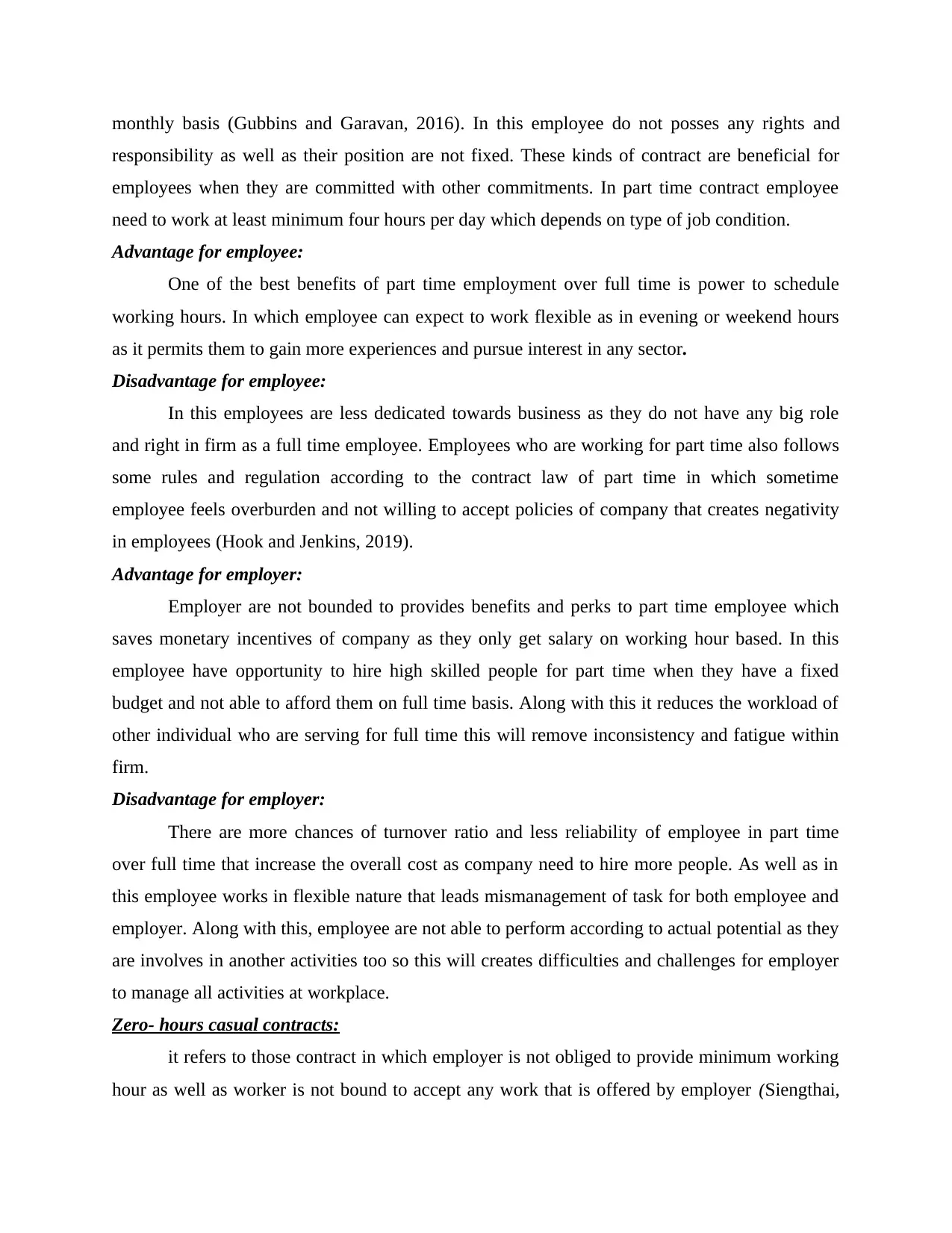
monthly basis (Gubbins and Garavan, 2016). In this employee do not posses any rights and
responsibility as well as their position are not fixed. These kinds of contract are beneficial for
employees when they are committed with other commitments. In part time contract employee
need to work at least minimum four hours per day which depends on type of job condition.
Advantage for employee:
One of the best benefits of part time employment over full time is power to schedule
working hours. In which employee can expect to work flexible as in evening or weekend hours
as it permits them to gain more experiences and pursue interest in any sector.
Disadvantage for employee:
In this employees are less dedicated towards business as they do not have any big role
and right in firm as a full time employee. Employees who are working for part time also follows
some rules and regulation according to the contract law of part time in which sometime
employee feels overburden and not willing to accept policies of company that creates negativity
in employees (Hook and Jenkins, 2019).
Advantage for employer:
Employer are not bounded to provides benefits and perks to part time employee which
saves monetary incentives of company as they only get salary on working hour based. In this
employee have opportunity to hire high skilled people for part time when they have a fixed
budget and not able to afford them on full time basis. Along with this it reduces the workload of
other individual who are serving for full time this will remove inconsistency and fatigue within
firm.
Disadvantage for employer:
There are more chances of turnover ratio and less reliability of employee in part time
over full time that increase the overall cost as company need to hire more people. As well as in
this employee works in flexible nature that leads mismanagement of task for both employee and
employer. Along with this, employee are not able to perform according to actual potential as they
are involves in another activities too so this will creates difficulties and challenges for employer
to manage all activities at workplace.
Zero- hours casual contracts:
it refers to those contract in which employer is not obliged to provide minimum working
hour as well as worker is not bound to accept any work that is offered by employer (Siengthai,
responsibility as well as their position are not fixed. These kinds of contract are beneficial for
employees when they are committed with other commitments. In part time contract employee
need to work at least minimum four hours per day which depends on type of job condition.
Advantage for employee:
One of the best benefits of part time employment over full time is power to schedule
working hours. In which employee can expect to work flexible as in evening or weekend hours
as it permits them to gain more experiences and pursue interest in any sector.
Disadvantage for employee:
In this employees are less dedicated towards business as they do not have any big role
and right in firm as a full time employee. Employees who are working for part time also follows
some rules and regulation according to the contract law of part time in which sometime
employee feels overburden and not willing to accept policies of company that creates negativity
in employees (Hook and Jenkins, 2019).
Advantage for employer:
Employer are not bounded to provides benefits and perks to part time employee which
saves monetary incentives of company as they only get salary on working hour based. In this
employee have opportunity to hire high skilled people for part time when they have a fixed
budget and not able to afford them on full time basis. Along with this it reduces the workload of
other individual who are serving for full time this will remove inconsistency and fatigue within
firm.
Disadvantage for employer:
There are more chances of turnover ratio and less reliability of employee in part time
over full time that increase the overall cost as company need to hire more people. As well as in
this employee works in flexible nature that leads mismanagement of task for both employee and
employer. Along with this, employee are not able to perform according to actual potential as they
are involves in another activities too so this will creates difficulties and challenges for employer
to manage all activities at workplace.
Zero- hours casual contracts:
it refers to those contract in which employer is not obliged to provide minimum working
hour as well as worker is not bound to accept any work that is offered by employer (Siengthai,
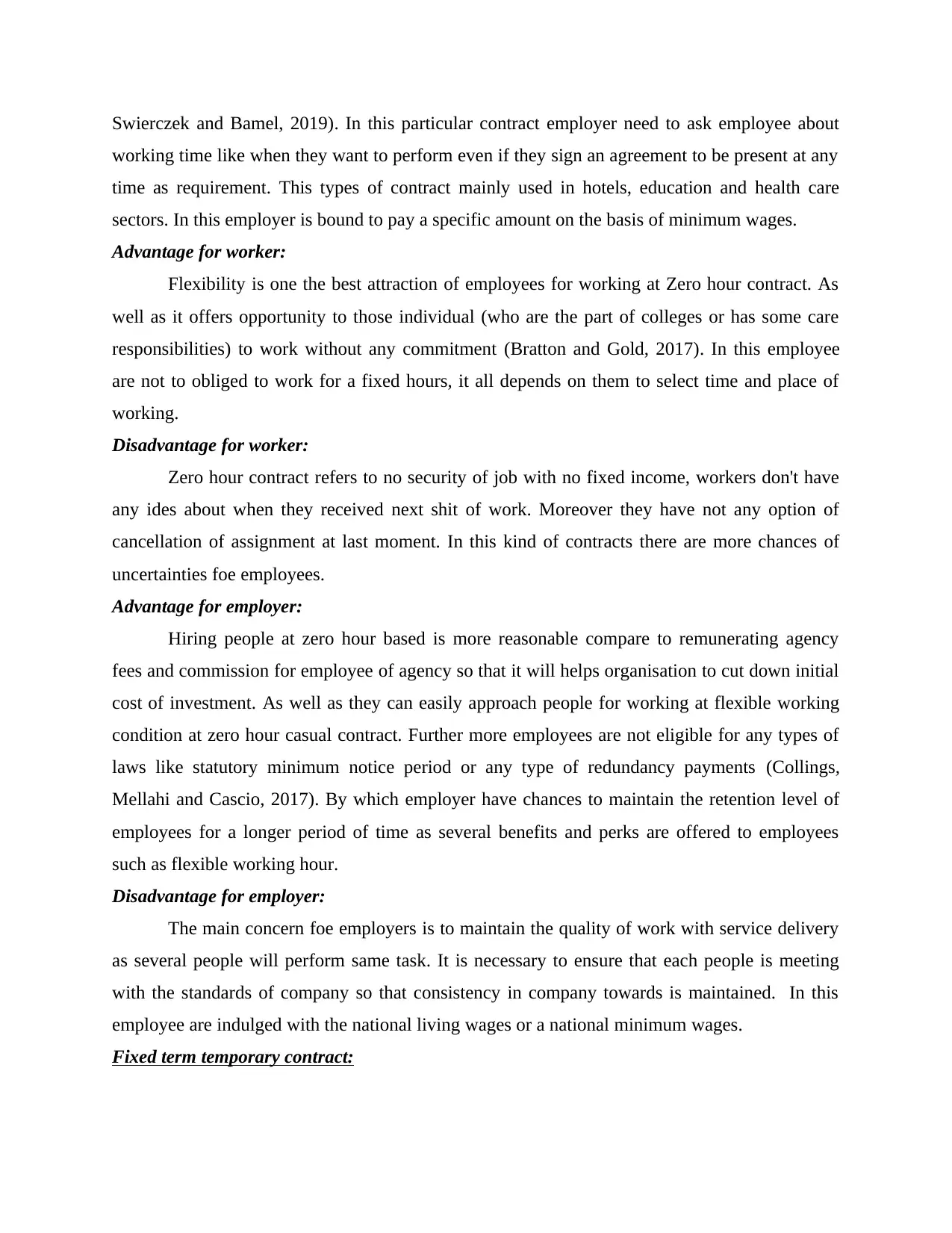
Swierczek and Bamel, 2019). In this particular contract employer need to ask employee about
working time like when they want to perform even if they sign an agreement to be present at any
time as requirement. This types of contract mainly used in hotels, education and health care
sectors. In this employer is bound to pay a specific amount on the basis of minimum wages.
Advantage for worker:
Flexibility is one the best attraction of employees for working at Zero hour contract. As
well as it offers opportunity to those individual (who are the part of colleges or has some care
responsibilities) to work without any commitment (Bratton and Gold, 2017). In this employee
are not to obliged to work for a fixed hours, it all depends on them to select time and place of
working.
Disadvantage for worker:
Zero hour contract refers to no security of job with no fixed income, workers don't have
any ides about when they received next shit of work. Moreover they have not any option of
cancellation of assignment at last moment. In this kind of contracts there are more chances of
uncertainties foe employees.
Advantage for employer:
Hiring people at zero hour based is more reasonable compare to remunerating agency
fees and commission for employee of agency so that it will helps organisation to cut down initial
cost of investment. As well as they can easily approach people for working at flexible working
condition at zero hour casual contract. Further more employees are not eligible for any types of
laws like statutory minimum notice period or any type of redundancy payments (Collings,
Mellahi and Cascio, 2017). By which employer have chances to maintain the retention level of
employees for a longer period of time as several benefits and perks are offered to employees
such as flexible working hour.
Disadvantage for employer:
The main concern foe employers is to maintain the quality of work with service delivery
as several people will perform same task. It is necessary to ensure that each people is meeting
with the standards of company so that consistency in company towards is maintained. In this
employee are indulged with the national living wages or a national minimum wages.
Fixed term temporary contract:
working time like when they want to perform even if they sign an agreement to be present at any
time as requirement. This types of contract mainly used in hotels, education and health care
sectors. In this employer is bound to pay a specific amount on the basis of minimum wages.
Advantage for worker:
Flexibility is one the best attraction of employees for working at Zero hour contract. As
well as it offers opportunity to those individual (who are the part of colleges or has some care
responsibilities) to work without any commitment (Bratton and Gold, 2017). In this employee
are not to obliged to work for a fixed hours, it all depends on them to select time and place of
working.
Disadvantage for worker:
Zero hour contract refers to no security of job with no fixed income, workers don't have
any ides about when they received next shit of work. Moreover they have not any option of
cancellation of assignment at last moment. In this kind of contracts there are more chances of
uncertainties foe employees.
Advantage for employer:
Hiring people at zero hour based is more reasonable compare to remunerating agency
fees and commission for employee of agency so that it will helps organisation to cut down initial
cost of investment. As well as they can easily approach people for working at flexible working
condition at zero hour casual contract. Further more employees are not eligible for any types of
laws like statutory minimum notice period or any type of redundancy payments (Collings,
Mellahi and Cascio, 2017). By which employer have chances to maintain the retention level of
employees for a longer period of time as several benefits and perks are offered to employees
such as flexible working hour.
Disadvantage for employer:
The main concern foe employers is to maintain the quality of work with service delivery
as several people will perform same task. It is necessary to ensure that each people is meeting
with the standards of company so that consistency in company towards is maintained. In this
employee are indulged with the national living wages or a national minimum wages.
Fixed term temporary contract:
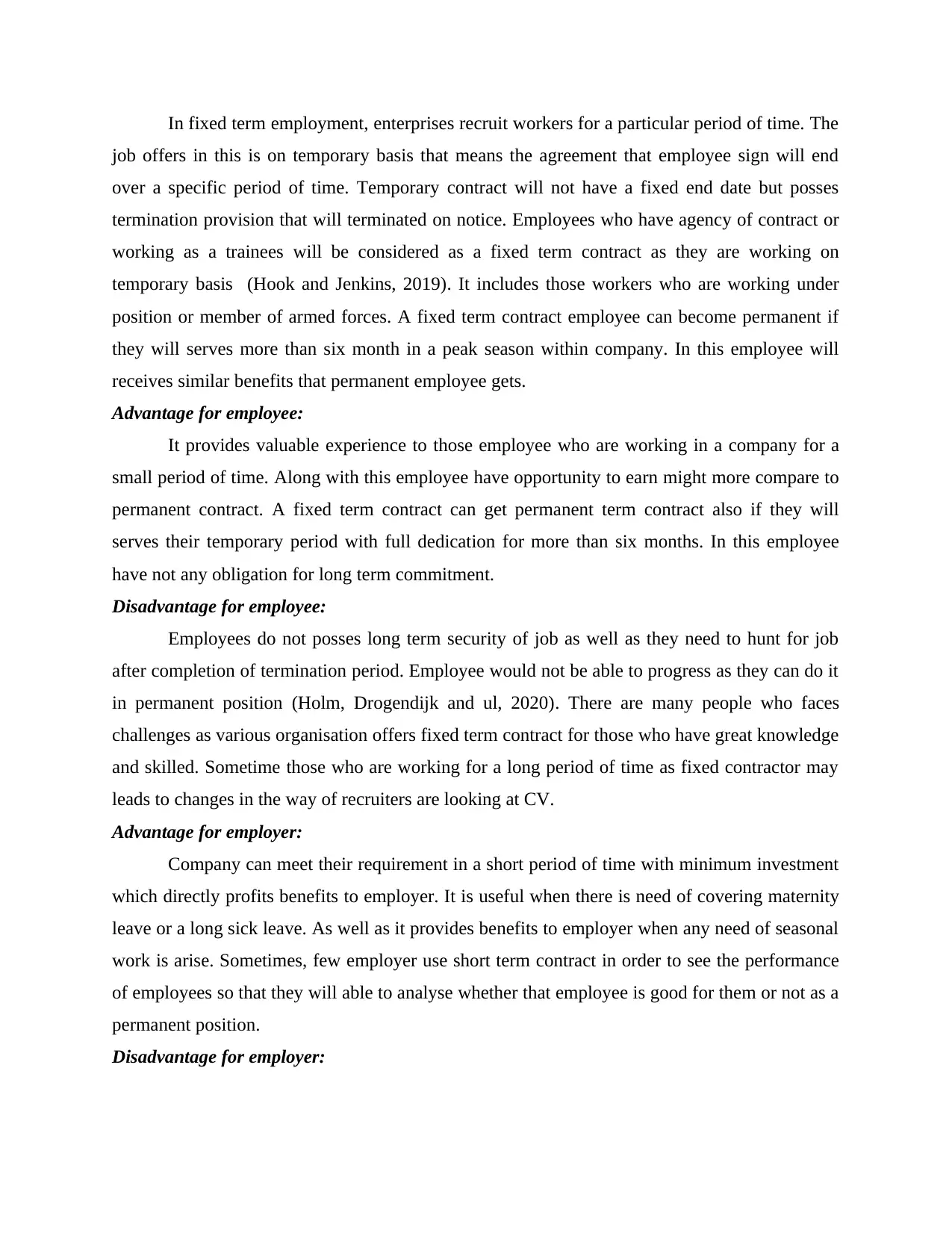
In fixed term employment, enterprises recruit workers for a particular period of time. The
job offers in this is on temporary basis that means the agreement that employee sign will end
over a specific period of time. Temporary contract will not have a fixed end date but posses
termination provision that will terminated on notice. Employees who have agency of contract or
working as a trainees will be considered as a fixed term contract as they are working on
temporary basis (Hook and Jenkins, 2019). It includes those workers who are working under
position or member of armed forces. A fixed term contract employee can become permanent if
they will serves more than six month in a peak season within company. In this employee will
receives similar benefits that permanent employee gets.
Advantage for employee:
It provides valuable experience to those employee who are working in a company for a
small period of time. Along with this employee have opportunity to earn might more compare to
permanent contract. A fixed term contract can get permanent term contract also if they will
serves their temporary period with full dedication for more than six months. In this employee
have not any obligation for long term commitment.
Disadvantage for employee:
Employees do not posses long term security of job as well as they need to hunt for job
after completion of termination period. Employee would not be able to progress as they can do it
in permanent position (Holm, Drogendijk and ul, 2020). There are many people who faces
challenges as various organisation offers fixed term contract for those who have great knowledge
and skilled. Sometime those who are working for a long period of time as fixed contractor may
leads to changes in the way of recruiters are looking at CV.
Advantage for employer:
Company can meet their requirement in a short period of time with minimum investment
which directly profits benefits to employer. It is useful when there is need of covering maternity
leave or a long sick leave. As well as it provides benefits to employer when any need of seasonal
work is arise. Sometimes, few employer use short term contract in order to see the performance
of employees so that they will able to analyse whether that employee is good for them or not as a
permanent position.
Disadvantage for employer:
job offers in this is on temporary basis that means the agreement that employee sign will end
over a specific period of time. Temporary contract will not have a fixed end date but posses
termination provision that will terminated on notice. Employees who have agency of contract or
working as a trainees will be considered as a fixed term contract as they are working on
temporary basis (Hook and Jenkins, 2019). It includes those workers who are working under
position or member of armed forces. A fixed term contract employee can become permanent if
they will serves more than six month in a peak season within company. In this employee will
receives similar benefits that permanent employee gets.
Advantage for employee:
It provides valuable experience to those employee who are working in a company for a
small period of time. Along with this employee have opportunity to earn might more compare to
permanent contract. A fixed term contract can get permanent term contract also if they will
serves their temporary period with full dedication for more than six months. In this employee
have not any obligation for long term commitment.
Disadvantage for employee:
Employees do not posses long term security of job as well as they need to hunt for job
after completion of termination period. Employee would not be able to progress as they can do it
in permanent position (Holm, Drogendijk and ul, 2020). There are many people who faces
challenges as various organisation offers fixed term contract for those who have great knowledge
and skilled. Sometime those who are working for a long period of time as fixed contractor may
leads to changes in the way of recruiters are looking at CV.
Advantage for employer:
Company can meet their requirement in a short period of time with minimum investment
which directly profits benefits to employer. It is useful when there is need of covering maternity
leave or a long sick leave. As well as it provides benefits to employer when any need of seasonal
work is arise. Sometimes, few employer use short term contract in order to see the performance
of employees so that they will able to analyse whether that employee is good for them or not as a
permanent position.
Disadvantage for employer:
Paraphrase This Document
Need a fresh take? Get an instant paraphrase of this document with our AI Paraphraser
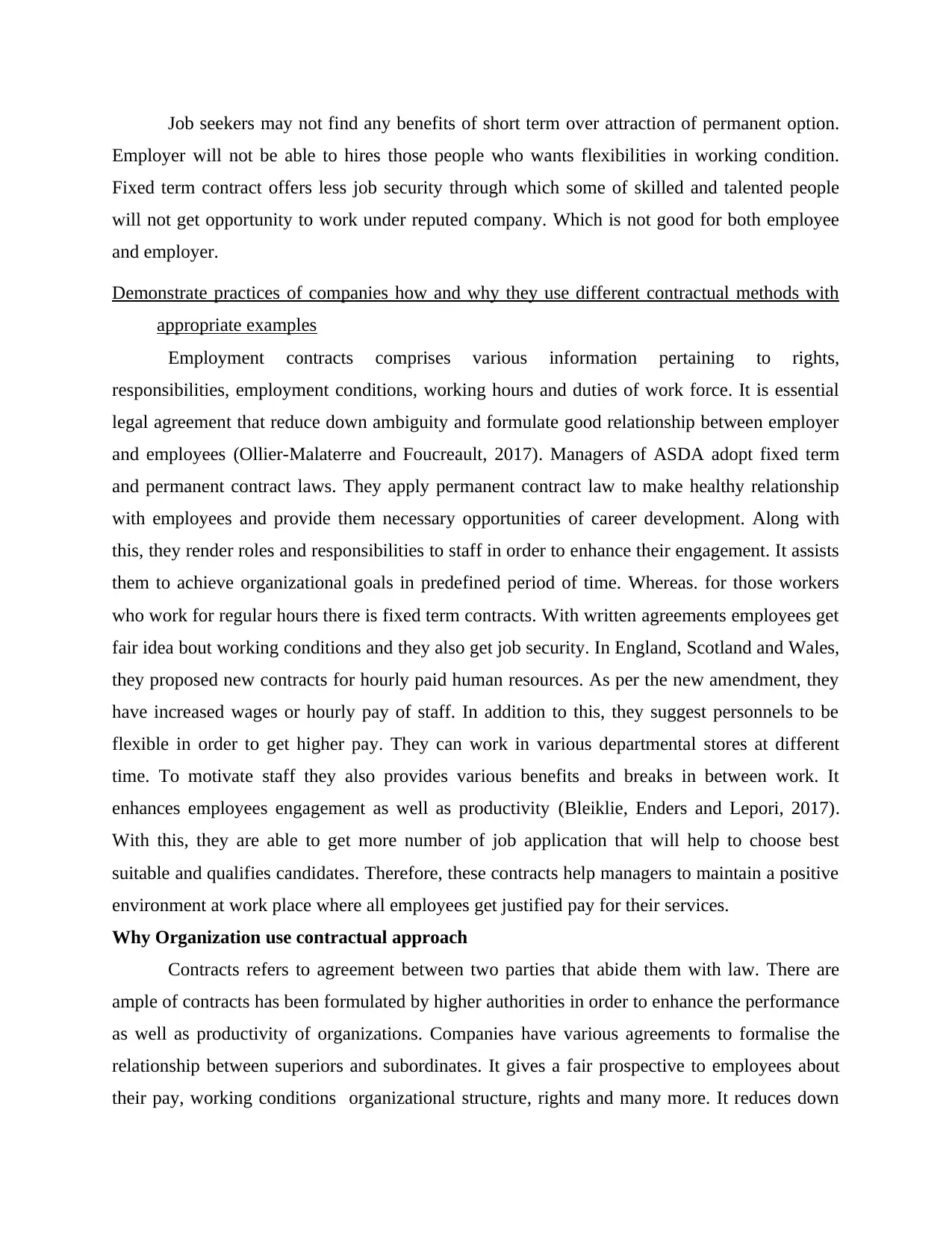
Job seekers may not find any benefits of short term over attraction of permanent option.
Employer will not be able to hires those people who wants flexibilities in working condition.
Fixed term contract offers less job security through which some of skilled and talented people
will not get opportunity to work under reputed company. Which is not good for both employee
and employer.
Demonstrate practices of companies how and why they use different contractual methods with
appropriate examples
Employment contracts comprises various information pertaining to rights,
responsibilities, employment conditions, working hours and duties of work force. It is essential
legal agreement that reduce down ambiguity and formulate good relationship between employer
and employees (Ollier-Malaterre and Foucreault, 2017). Managers of ASDA adopt fixed term
and permanent contract laws. They apply permanent contract law to make healthy relationship
with employees and provide them necessary opportunities of career development. Along with
this, they render roles and responsibilities to staff in order to enhance their engagement. It assists
them to achieve organizational goals in predefined period of time. Whereas. for those workers
who work for regular hours there is fixed term contracts. With written agreements employees get
fair idea bout working conditions and they also get job security. In England, Scotland and Wales,
they proposed new contracts for hourly paid human resources. As per the new amendment, they
have increased wages or hourly pay of staff. In addition to this, they suggest personnels to be
flexible in order to get higher pay. They can work in various departmental stores at different
time. To motivate staff they also provides various benefits and breaks in between work. It
enhances employees engagement as well as productivity (Bleiklie, Enders and Lepori, 2017).
With this, they are able to get more number of job application that will help to choose best
suitable and qualifies candidates. Therefore, these contracts help managers to maintain a positive
environment at work place where all employees get justified pay for their services.
Why Organization use contractual approach
Contracts refers to agreement between two parties that abide them with law. There are
ample of contracts has been formulated by higher authorities in order to enhance the performance
as well as productivity of organizations. Companies have various agreements to formalise the
relationship between superiors and subordinates. It gives a fair prospective to employees about
their pay, working conditions organizational structure, rights and many more. It reduces down
Employer will not be able to hires those people who wants flexibilities in working condition.
Fixed term contract offers less job security through which some of skilled and talented people
will not get opportunity to work under reputed company. Which is not good for both employee
and employer.
Demonstrate practices of companies how and why they use different contractual methods with
appropriate examples
Employment contracts comprises various information pertaining to rights,
responsibilities, employment conditions, working hours and duties of work force. It is essential
legal agreement that reduce down ambiguity and formulate good relationship between employer
and employees (Ollier-Malaterre and Foucreault, 2017). Managers of ASDA adopt fixed term
and permanent contract laws. They apply permanent contract law to make healthy relationship
with employees and provide them necessary opportunities of career development. Along with
this, they render roles and responsibilities to staff in order to enhance their engagement. It assists
them to achieve organizational goals in predefined period of time. Whereas. for those workers
who work for regular hours there is fixed term contracts. With written agreements employees get
fair idea bout working conditions and they also get job security. In England, Scotland and Wales,
they proposed new contracts for hourly paid human resources. As per the new amendment, they
have increased wages or hourly pay of staff. In addition to this, they suggest personnels to be
flexible in order to get higher pay. They can work in various departmental stores at different
time. To motivate staff they also provides various benefits and breaks in between work. It
enhances employees engagement as well as productivity (Bleiklie, Enders and Lepori, 2017).
With this, they are able to get more number of job application that will help to choose best
suitable and qualifies candidates. Therefore, these contracts help managers to maintain a positive
environment at work place where all employees get justified pay for their services.
Why Organization use contractual approach
Contracts refers to agreement between two parties that abide them with law. There are
ample of contracts has been formulated by higher authorities in order to enhance the performance
as well as productivity of organizations. Companies have various agreements to formalise the
relationship between superiors and subordinates. It gives a fair prospective to employees about
their pay, working conditions organizational structure, rights and many more. It reduces down
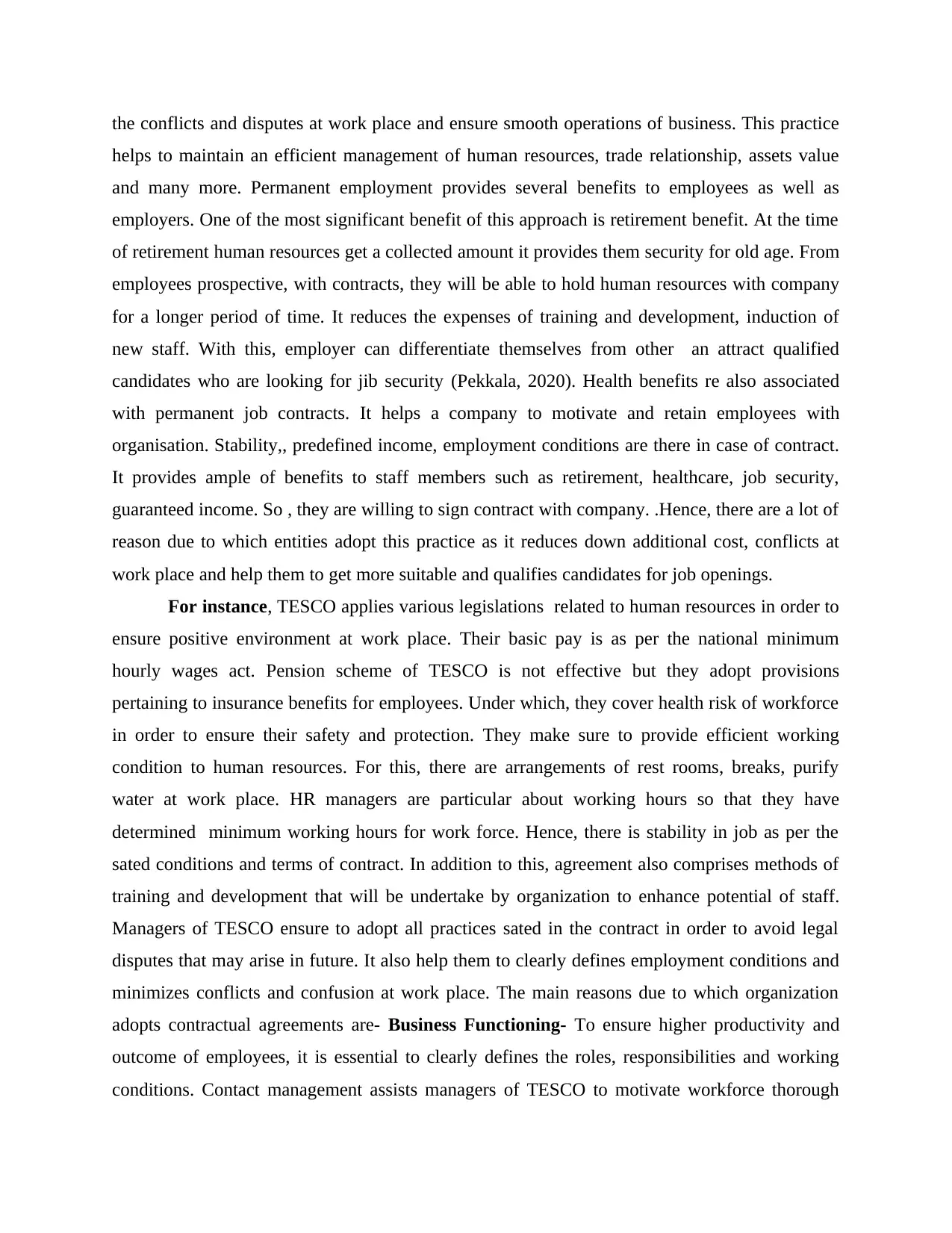
the conflicts and disputes at work place and ensure smooth operations of business. This practice
helps to maintain an efficient management of human resources, trade relationship, assets value
and many more. Permanent employment provides several benefits to employees as well as
employers. One of the most significant benefit of this approach is retirement benefit. At the time
of retirement human resources get a collected amount it provides them security for old age. From
employees prospective, with contracts, they will be able to hold human resources with company
for a longer period of time. It reduces the expenses of training and development, induction of
new staff. With this, employer can differentiate themselves from other an attract qualified
candidates who are looking for jib security (Pekkala, 2020). Health benefits re also associated
with permanent job contracts. It helps a company to motivate and retain employees with
organisation. Stability,, predefined income, employment conditions are there in case of contract.
It provides ample of benefits to staff members such as retirement, healthcare, job security,
guaranteed income. So , they are willing to sign contract with company. .Hence, there are a lot of
reason due to which entities adopt this practice as it reduces down additional cost, conflicts at
work place and help them to get more suitable and qualifies candidates for job openings.
For instance, TESCO applies various legislations related to human resources in order to
ensure positive environment at work place. Their basic pay is as per the national minimum
hourly wages act. Pension scheme of TESCO is not effective but they adopt provisions
pertaining to insurance benefits for employees. Under which, they cover health risk of workforce
in order to ensure their safety and protection. They make sure to provide efficient working
condition to human resources. For this, there are arrangements of rest rooms, breaks, purify
water at work place. HR managers are particular about working hours so that they have
determined minimum working hours for work force. Hence, there is stability in job as per the
sated conditions and terms of contract. In addition to this, agreement also comprises methods of
training and development that will be undertake by organization to enhance potential of staff.
Managers of TESCO ensure to adopt all practices sated in the contract in order to avoid legal
disputes that may arise in future. It also help them to clearly defines employment conditions and
minimizes conflicts and confusion at work place. The main reasons due to which organization
adopts contractual agreements are- Business Functioning- To ensure higher productivity and
outcome of employees, it is essential to clearly defines the roles, responsibilities and working
conditions. Contact management assists managers of TESCO to motivate workforce thorough
helps to maintain an efficient management of human resources, trade relationship, assets value
and many more. Permanent employment provides several benefits to employees as well as
employers. One of the most significant benefit of this approach is retirement benefit. At the time
of retirement human resources get a collected amount it provides them security for old age. From
employees prospective, with contracts, they will be able to hold human resources with company
for a longer period of time. It reduces the expenses of training and development, induction of
new staff. With this, employer can differentiate themselves from other an attract qualified
candidates who are looking for jib security (Pekkala, 2020). Health benefits re also associated
with permanent job contracts. It helps a company to motivate and retain employees with
organisation. Stability,, predefined income, employment conditions are there in case of contract.
It provides ample of benefits to staff members such as retirement, healthcare, job security,
guaranteed income. So , they are willing to sign contract with company. .Hence, there are a lot of
reason due to which entities adopt this practice as it reduces down additional cost, conflicts at
work place and help them to get more suitable and qualifies candidates for job openings.
For instance, TESCO applies various legislations related to human resources in order to
ensure positive environment at work place. Their basic pay is as per the national minimum
hourly wages act. Pension scheme of TESCO is not effective but they adopt provisions
pertaining to insurance benefits for employees. Under which, they cover health risk of workforce
in order to ensure their safety and protection. They make sure to provide efficient working
condition to human resources. For this, there are arrangements of rest rooms, breaks, purify
water at work place. HR managers are particular about working hours so that they have
determined minimum working hours for work force. Hence, there is stability in job as per the
sated conditions and terms of contract. In addition to this, agreement also comprises methods of
training and development that will be undertake by organization to enhance potential of staff.
Managers of TESCO ensure to adopt all practices sated in the contract in order to avoid legal
disputes that may arise in future. It also help them to clearly defines employment conditions and
minimizes conflicts and confusion at work place. The main reasons due to which organization
adopts contractual agreements are- Business Functioning- To ensure higher productivity and
outcome of employees, it is essential to clearly defines the roles, responsibilities and working
conditions. Contact management assists managers of TESCO to motivate workforce thorough
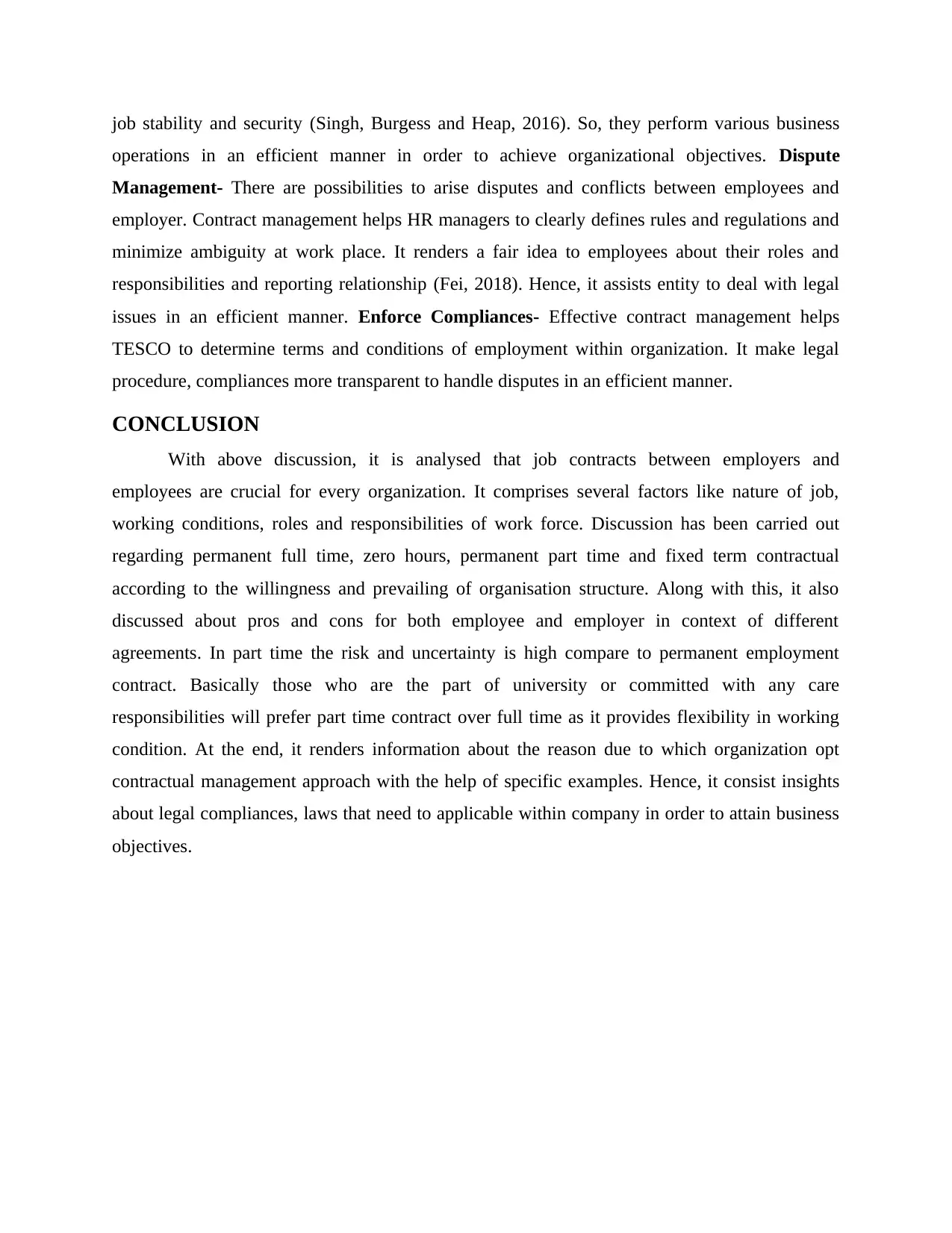
job stability and security (Singh, Burgess and Heap, 2016). So, they perform various business
operations in an efficient manner in order to achieve organizational objectives. Dispute
Management- There are possibilities to arise disputes and conflicts between employees and
employer. Contract management helps HR managers to clearly defines rules and regulations and
minimize ambiguity at work place. It renders a fair idea to employees about their roles and
responsibilities and reporting relationship (Fei, 2018). Hence, it assists entity to deal with legal
issues in an efficient manner. Enforce Compliances- Effective contract management helps
TESCO to determine terms and conditions of employment within organization. It make legal
procedure, compliances more transparent to handle disputes in an efficient manner.
CONCLUSION
With above discussion, it is analysed that job contracts between employers and
employees are crucial for every organization. It comprises several factors like nature of job,
working conditions, roles and responsibilities of work force. Discussion has been carried out
regarding permanent full time, zero hours, permanent part time and fixed term contractual
according to the willingness and prevailing of organisation structure. Along with this, it also
discussed about pros and cons for both employee and employer in context of different
agreements. In part time the risk and uncertainty is high compare to permanent employment
contract. Basically those who are the part of university or committed with any care
responsibilities will prefer part time contract over full time as it provides flexibility in working
condition. At the end, it renders information about the reason due to which organization opt
contractual management approach with the help of specific examples. Hence, it consist insights
about legal compliances, laws that need to applicable within company in order to attain business
objectives.
operations in an efficient manner in order to achieve organizational objectives. Dispute
Management- There are possibilities to arise disputes and conflicts between employees and
employer. Contract management helps HR managers to clearly defines rules and regulations and
minimize ambiguity at work place. It renders a fair idea to employees about their roles and
responsibilities and reporting relationship (Fei, 2018). Hence, it assists entity to deal with legal
issues in an efficient manner. Enforce Compliances- Effective contract management helps
TESCO to determine terms and conditions of employment within organization. It make legal
procedure, compliances more transparent to handle disputes in an efficient manner.
CONCLUSION
With above discussion, it is analysed that job contracts between employers and
employees are crucial for every organization. It comprises several factors like nature of job,
working conditions, roles and responsibilities of work force. Discussion has been carried out
regarding permanent full time, zero hours, permanent part time and fixed term contractual
according to the willingness and prevailing of organisation structure. Along with this, it also
discussed about pros and cons for both employee and employer in context of different
agreements. In part time the risk and uncertainty is high compare to permanent employment
contract. Basically those who are the part of university or committed with any care
responsibilities will prefer part time contract over full time as it provides flexibility in working
condition. At the end, it renders information about the reason due to which organization opt
contractual management approach with the help of specific examples. Hence, it consist insights
about legal compliances, laws that need to applicable within company in order to attain business
objectives.
Secure Best Marks with AI Grader
Need help grading? Try our AI Grader for instant feedback on your assignments.
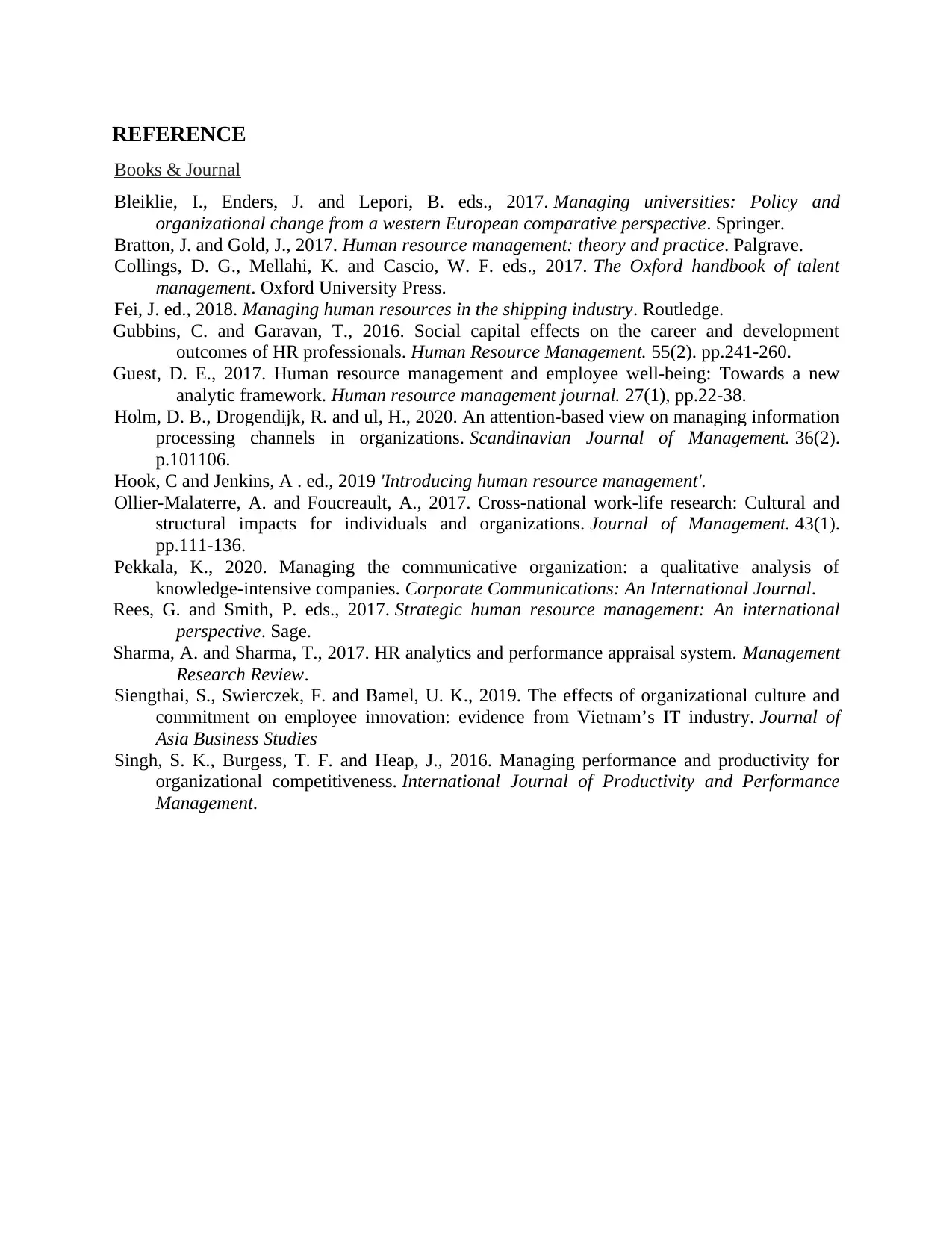
REFERENCE
Books & Journal
Bleiklie, I., Enders, J. and Lepori, B. eds., 2017. Managing universities: Policy and
organizational change from a western European comparative perspective. Springer.
Bratton, J. and Gold, J., 2017. Human resource management: theory and practice. Palgrave.
Collings, D. G., Mellahi, K. and Cascio, W. F. eds., 2017. The Oxford handbook of talent
management. Oxford University Press.
Fei, J. ed., 2018. Managing human resources in the shipping industry. Routledge.
Gubbins, C. and Garavan, T., 2016. Social capital effects on the career and development
outcomes of HR professionals. Human Resource Management. 55(2). pp.241-260.
Guest, D. E., 2017. Human resource management and employee well‐being: Towards a new
analytic framework. Human resource management journal. 27(1), pp.22-38.
Holm, D. B., Drogendijk, R. and ul, H., 2020. An attention-based view on managing information
processing channels in organizations. Scandinavian Journal of Management. 36(2).
p.101106.
Hook, C and Jenkins, A . ed., 2019 'Introducing human resource management'.
Ollier-Malaterre, A. and Foucreault, A., 2017. Cross-national work-life research: Cultural and
structural impacts for individuals and organizations. Journal of Management. 43(1).
pp.111-136.
Pekkala, K., 2020. Managing the communicative organization: a qualitative analysis of
knowledge-intensive companies. Corporate Communications: An International Journal.
Rees, G. and Smith, P. eds., 2017. Strategic human resource management: An international
perspective. Sage.
Sharma, A. and Sharma, T., 2017. HR analytics and performance appraisal system. Management
Research Review.
Siengthai, S., Swierczek, F. and Bamel, U. K., 2019. The effects of organizational culture and
commitment on employee innovation: evidence from Vietnam’s IT industry. Journal of
Asia Business Studies
Singh, S. K., Burgess, T. F. and Heap, J., 2016. Managing performance and productivity for
organizational competitiveness. International Journal of Productivity and Performance
Management.
Books & Journal
Bleiklie, I., Enders, J. and Lepori, B. eds., 2017. Managing universities: Policy and
organizational change from a western European comparative perspective. Springer.
Bratton, J. and Gold, J., 2017. Human resource management: theory and practice. Palgrave.
Collings, D. G., Mellahi, K. and Cascio, W. F. eds., 2017. The Oxford handbook of talent
management. Oxford University Press.
Fei, J. ed., 2018. Managing human resources in the shipping industry. Routledge.
Gubbins, C. and Garavan, T., 2016. Social capital effects on the career and development
outcomes of HR professionals. Human Resource Management. 55(2). pp.241-260.
Guest, D. E., 2017. Human resource management and employee well‐being: Towards a new
analytic framework. Human resource management journal. 27(1), pp.22-38.
Holm, D. B., Drogendijk, R. and ul, H., 2020. An attention-based view on managing information
processing channels in organizations. Scandinavian Journal of Management. 36(2).
p.101106.
Hook, C and Jenkins, A . ed., 2019 'Introducing human resource management'.
Ollier-Malaterre, A. and Foucreault, A., 2017. Cross-national work-life research: Cultural and
structural impacts for individuals and organizations. Journal of Management. 43(1).
pp.111-136.
Pekkala, K., 2020. Managing the communicative organization: a qualitative analysis of
knowledge-intensive companies. Corporate Communications: An International Journal.
Rees, G. and Smith, P. eds., 2017. Strategic human resource management: An international
perspective. Sage.
Sharma, A. and Sharma, T., 2017. HR analytics and performance appraisal system. Management
Research Review.
Siengthai, S., Swierczek, F. and Bamel, U. K., 2019. The effects of organizational culture and
commitment on employee innovation: evidence from Vietnam’s IT industry. Journal of
Asia Business Studies
Singh, S. K., Burgess, T. F. and Heap, J., 2016. Managing performance and productivity for
organizational competitiveness. International Journal of Productivity and Performance
Management.
1 out of 11
Related Documents
Your All-in-One AI-Powered Toolkit for Academic Success.
+13062052269
info@desklib.com
Available 24*7 on WhatsApp / Email
![[object Object]](/_next/static/media/star-bottom.7253800d.svg)
Unlock your academic potential
© 2024 | Zucol Services PVT LTD | All rights reserved.





